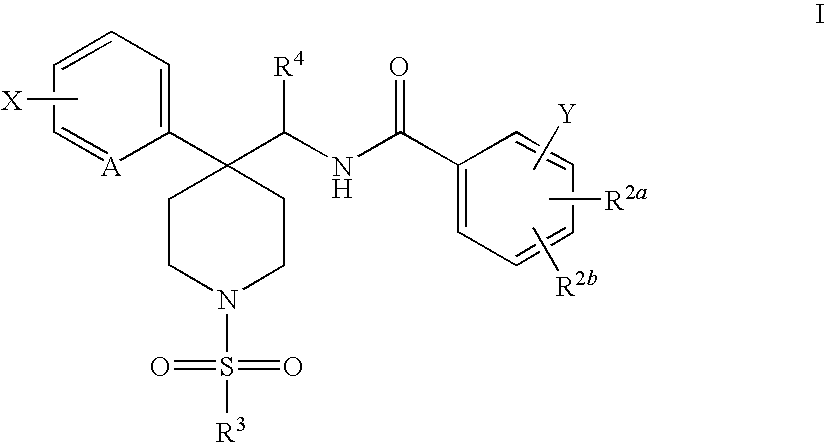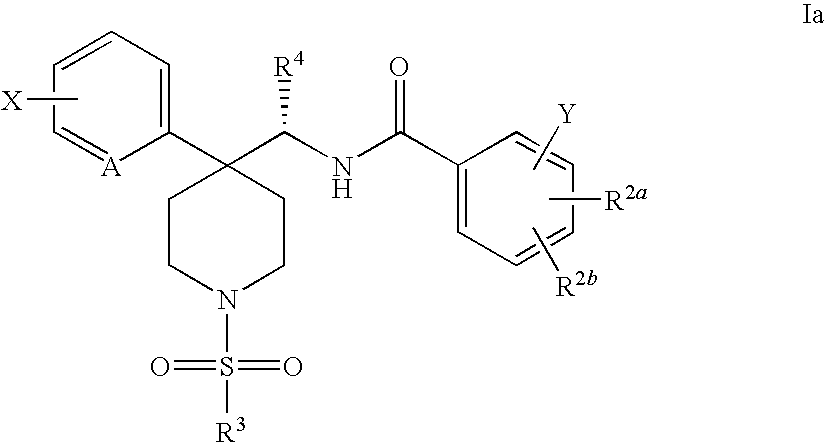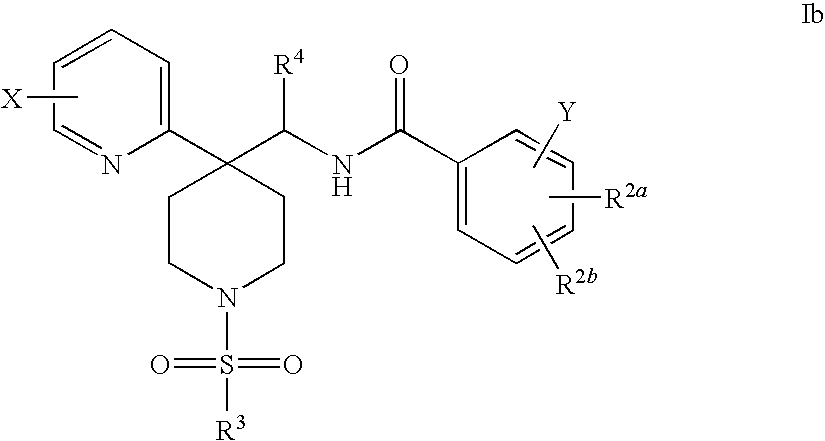Radiolabeled glycine transporter inhibitors
a technology of radiolabeled glycine and transporter, which is applied in the direction of therapy, biocide, heterocyclic compound active ingredients, etc., can solve the problems of limiting their use and inability to obtain much of the information by other means
- Summary
- Abstract
- Description
- Claims
- Application Information
AI Technical Summary
Benefits of technology
Problems solved by technology
Method used
Image
Examples
example 1
[0080]
[18F] 2-Fluoro-6-fluoromethoxy-N-{[4-phenyl-1-(propylsulfonyl)piperidin-4-yl]ethyl}benzamide-d2
[0081]The resin containing the [18F]F− was eluted with 1.5 mL of a solution of 80:20 MeCN:Oxalate solution [0.05 mL of (200 mg K2C2O4 / 3 mg K2CO3 / 5 mL H2O)+0.25 mL H2O+1.2 mL MeCN] and transferred to the reaction vessel giving 586 mCi of activity. A solution (0.2 mL) of Kryptofix222 (36 mg / mL MeCN) was added and the mixture was heated to 95° C. under vacuum and argon flow to dryness. Additional aliquots of MeCN (3×0.7 mL) were used to further dry the [18F]F−. A solution of CD2Br2 (0.05 mL) in MeCN (1 mL) was added and the mixture was heated at 95° C. Argon flow was used to distill the [18F]FCD2Br into a 0° C. mixture of 2-fluoro-6-hydroxy-N-{[4-phenyl-1-(propylsulfonyl)piperidin-4-yl]ethyl}benzamide (0.3 mg) [prepared as described in PCT publication WO2005 / 046601] in DMF (0.2 mL) containing Cs2CO3 (˜1-2 mg). When the amount of trapped activity was sufficient, the mixture was heated a...
example 2
[0086]
[18F]2-Chloro-6-fluoro-N-{[1-(propylsulfonyl)-4-pyridin-2-ylpiperidin-4-yl]ethyl}benzamide
[0087]The [18F]F− containing anion exchange resin was eluted with a mixture (1 mL) of 80% MeCN:20% oxalate*(aq.) solution [*0.05 mL of (200 mg K2C2O4 / 3 mg K2CO3 / 5 mL H2O)+0.25 mL H2O+1.2 mL MeCN] and added to a 1 mL v-vial in the microwave cavity. This vial was vented using an 18G1 syringe needle attached to a gas bag. To the aqueous fluoride solution (51 mCi) was added Kryptofix222 (0.2 mL, 36 mg / mL MeCN) and the fluoride was dried under argon flow in the microwave (35 W, 65° C.). Additional aliquots of acetonitrile (3×0.5 mL) were added for azeotropic drying. A solution of 2,6-dichloro-N-{[1-(propylsulfonyl)-4-pyridin-2-ylpiperidin-4-yl]ethyl}benzamide (1.1 mg) in DMSO (0.2 mL) was added to the microwave vial, the vent line was removed, and the reaction mixture was heated at 100 W, 150° C. for 4 minutes. After cooling to 2O (0.8 mL) and purified by HPLC (Waters C18 XTerra, 7.8×150 mm, 7...
example 3
[0092]
[11C] 2,4-Dichloro-N-{[4-(3-methoxypyridin-2-yl)-1-(propylsulfonyl)piperidin 4-yl]methyl}benzamide
[0093]The [11C]MeI was trapped at 0° C. in a mixture of 2,4-dichloro-N-{[4-(3-hydroxypyridin-2-yl)-1-(propylsulfonyl)piperidin-4-yl]methyl}benzamide (0.25 mg) in DMF (0.2 mL) containing Cs2CO3 (1-2 mg). This mixture was transferred to a vial at 100° C. and heated for five minutes. The reaction was diluted with H2O (0.8 μL) and purified by HPLC (Waters C18 XTerra, 7.8×150 mm, 5 μm, 15 minutes linear gradient 20% MeCN:(95:5:0.1) H2O:MeCN:TFA to 90% MeCN @ 3 mL / min, product elutes at 8.5 minutes). The product fraction was collected in a heated round bottom flask attached to a rotary evaporator, the solvent was removed and the product was transferred to a vial using physiologic saline to give to give 65 mCi of [11C] 2,4-dichloro-N-{[4-(3-methoxypyridin-2-yl)-1-(propylsulfonyl)piperidin-4-yl]methyl}benzamide.
Intermediate 4
[0094]
2,4-Dichloro-N-{[4-(6-chloropyridin-2-yl)-1-(propylsulfony...
PUM
| Property | Measurement | Unit |
|---|---|---|
| pH | aaaaa | aaaaa |
| temperature | aaaaa | aaaaa |
| pH | aaaaa | aaaaa |
Abstract
Description
Claims
Application Information
 Login to View More
Login to View More - R&D
- Intellectual Property
- Life Sciences
- Materials
- Tech Scout
- Unparalleled Data Quality
- Higher Quality Content
- 60% Fewer Hallucinations
Browse by: Latest US Patents, China's latest patents, Technical Efficacy Thesaurus, Application Domain, Technology Topic, Popular Technical Reports.
© 2025 PatSnap. All rights reserved.Legal|Privacy policy|Modern Slavery Act Transparency Statement|Sitemap|About US| Contact US: help@patsnap.com



